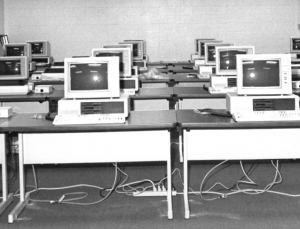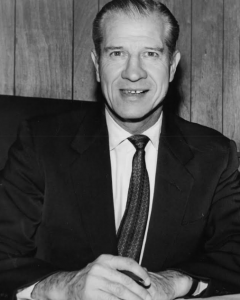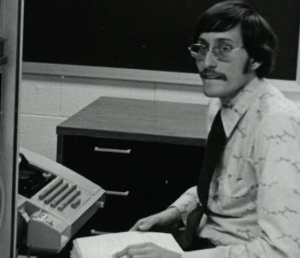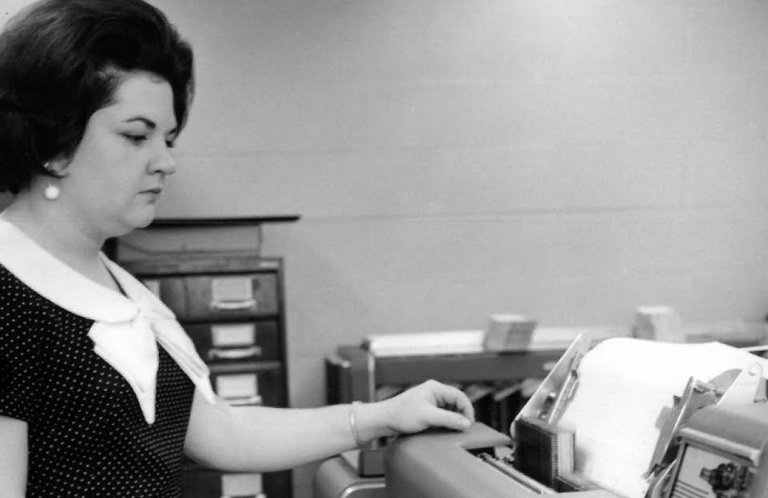By Dr. Raymond Hebert
Thomas More University
Part 55 of our series, “Retrospect and Vista II” Thomas More College/University 1971-2021
It was Sister Mary Elizabeth Frisch, O.S.B., Ph.D. (from the Catholic University of America, according to Thomas Henry Hanna (Dissertation – “The History and Status of Villa Madonna College; 1962 – University of Cincinnati) who provided the primary details about the early history of the department of Mathematics at Villa Madonna College.

Sister Mary Elizabeth Frisch, O.S.B., Ph.D., early chair of the Mathematics department. (TMU Archives)
The Mathematics department was contained within the Sciences until 1929. Sister M. Domitilla Thuener, O.S.B. served as the first chair of the combined departments (1921–1929) and then as chair of the separate department of Mathematics (1929–1943). She was then followed by Sister Mary Elizabeth Frisch, who was chair at the time of Dr. Hanna’s 1961 dissertation. At that time, the faculty in the department included James Brooks, Sr. Mary Hulitta Ege, O.S.B., Sister Mary Rose Rauen, O.S.B., William Bettenhorn, and Lawrence Mammering, with others being added in 1961, namely Robert L. Becker, John McAnow, and Harvey Weitkamp (Hanna dissertation, p. 248).
It was noted, as a sign of things to come, that “through the June graduation of 1961, 61 Mathematics majors have graduated from the college; with 36 presently concentrating in Mathematics in the Spring of 1961. Eighteen graduates in the department went on for graduate study, and of this number, six obtained their master’s degree, one a doctorate, and four are currently (1961) in graduate school” (Hanna dissertation). The dissertation then described the major offerings, adding that all the student majors in Physics and Chemistry were required to take Mathematics courses every year.
Sister Mary Elizabeth’s conclusion was that: “during the years 1960 and 1961, in addition to revising its curriculum, the Department of Mathematics has strengthened its course offerings and raised its standard of performance expected of students in order to meet the demands of graduate schools of science that incoming students be better-prepared in the field of Mathematics” (Hanna dissertation, p. 249). Clearly, Villa Madonna College’s pursuit of respectability as a liberal arts institution could count on the strength of the Mathematics department as guaranteed by the founding order of Benedictine sisters and its mathematicians, Sister M. Domitilla Thuener, O.S.B., Sister Mary Elizabeth Frisch, O.S.B., and Sister M. Rose Rauen, O.S.B.

Kenneth Taylor and Steven Lameier, long-standing faculty members of the
Mathematics department. (TMU Archives)
Not long afterwards, two laymen played an important role in what would be the direction of the math department over the next few decades: Dr. Steven H. Lameier and Mr. Kenneth Taylor (who would become one of the long-standing faculty members of the college’s Computer Science program in the 1970s). Dr. Lameier was hired as a full-time faculty member in 1969 while completing his PhD at the University of Cincinnati (1973). He began as an instructor (1969–1972); then Assistant Professor (1972–1978); Associate Professor (1978–1982+) and served as chair for many years, beginning in 1982.
Dr. Lameier’s research was “Computer applications, probability and statistics, numerical analysis, approximation theory, univalent function theory, number theory, and real and complex analysis” (Steven H. Lameier, Curriculum Vita, March 26, 1968, TMU Archives). Dr. Lameier had worked for consulting firms. In addition, he had received teaching fellowships, NASA traineeships, and NSF/Phi Beta Kappa Fellowships. Consistently, year after year, Lameier received positive teaching evaluations. He was a major pillar in the department’s success for the remainder of the 20th Century (mostly as chair) and into the beginning of the 21st Century. Other members of the Mathematics faculty during those years included Thomas Vanden Eynden, Debbie Calloway, and Jack Wells (who also taught Physics and is still with Thomas More College in the 2020s).
The most influential counterpart to Steve Lameier was Kenneth Taylor, who also served Villa Madonna/Thomas More College for multiple decades, first in Mathematics and later in Computer Science. Like Dr. Lameier, Ken also started in the 1960s (1966), rising to the rank of Associate Professor.
Taylor served as chair of the Mathematics department from 1970–1981, and then chair of Computer Science from 1981–1998.

Early computer lab at Thomas More College (1969). (TMU Archives)
Ken Taylor’s background was varied, making him a perfect fit for a liberal arts institution like VMC/TMC. He began at Villa Madonna soon after completing both a Masters in Math Education at Xavier University (1964) and an MS in Math from Ohio State in 1966, continuing there for years as an “All but Dissertation” candidate in math before shifting his direction to the new emerging field of Computer Science. In preparation, he completed the required graduate credit hours at a combination of the University of Central Oklahoma and James Madison University. For the remainder of his Thomas More College career, until his retirement in 2011, Ken Taylor was a backbone of the college’s computer science program.
It seemed to have been divine providence that the arrival of faculty, like professor Lameier and Taylor coincided with the move of the college to the Crestview Hills campus. On July 8, 1968, John L. Krebs, the College’s first Computer Center director, submitted a proposal for what would be the college’s first computer. In the words of the proposal: “in order to retain its stature as a first-class institution Thomas More College must upgrade faculty in the use and application of computer technology in its educational curriculum (and) our presently enrolled students with the use and application of computers regardless of their field of endeavor” (“Proposal for a Computer Installation at Thomas More College, July 9, 1968, p. 2, TMU Archives). This was assuredly a prophecy that would set the stage for what would follow.

John L. Krebs, Thomas More’s first Computer Center director (1968). (TMU Archives)
It was just a few months later (August 28, 1968) that a proposal was submitted for support in acquiring a computer installation for the college. The grant that followed was for $57,400 (Press Release from President John Murphy, October 8, 1968, TMU Archives). It was noted that the first faculty hired for the center would be Robert John Graham, as a part-time instructor and part-time programmer. The press notice continued that “the NSF grant exceeds any other to an institution the size of Thomas More College” (Press Release). TMC had entered the computer world. The new director of the Computer Center would be Margaret Geis.
The installation of a Connect/Campus Management System followed, along with the creation of an academic major and department in Computer Science. Among the early leaders in the development of the program were James McDevitt, Charles Bender, and eventually Dr. Carl Evert, all encouraged by Academic Dean Dr. James Ebben and Dean of the Faculty Dr. Ron Mann. Dr. Evert would become a co-author in 1979 of What Every Engineer Should Know About Microcomputers: Hardware/Software Design, while serving as a faculty member at Thomas More.
The administration strongly encouraged interactions with other departments for the Computer Science faculty and students, as well as inclusion of at least one cooperative education (co-op) experience. Thomas More was helped by Dr. Evert’s experience at the University of Cincinnati, where he had taught for decades and was a Professor Emeritus in the Department of Electrical and Computer Engineering. UC had been one of the leading co-op-based institutions in the United States. In 1978, President Robert Giroux named Dr. Evert as “Special Advisor to the President for Computer Affairs” (Letter from President Robert Giroux to Dean of Faculty Dr. Ron Mann, to whom Dr. Evert had previously reported, August 7, 1978, TMU Archives).

Dr. Carl Evert, faculty member for the Computer Science department. He was eventually selected by President Robert Giroux to be the special advisor to the president for computer affairs. (TMU Archives)
In a letter from Dr. Carl Evert to Thomas More College (September 10, 1977), he suggested that the “objective of the Computer Science Department at Thomas More is to develop an educational program within the context of the liberal arts environment which will equip students with employable skills and a comprehensive appreciation of the cultural implications of Computer technology in a modern society” (Dr. Carl F. Evert proposal for the “Development of a Computer Science Program at Thomas More College,” September 10, 1977, TMU Archives).
Over the next several decades, Dr. Evert’s dream would reach fruition as his concept guided many talented faculty and staff in the Computer Center and Computer Science department through the balance of the 20th Century. The full-time faculty included Thomas Hext and Dorene Stall, and the trailblazing staff members were Teresa Blum, Jay Blum, Chris Heist and Bill Swisher. Dave Manning preceded professors Hext and Stall. Two faculty from related fields with expertise and involvement were Dr. Bill Porter (Psychology) and Dr. Jim Swartz (Chemistry).

Dave Manning, a talented faculty member in the Computer Science department. (TMU Archives)
As noted previously, our longtime mathematician, Ken Taylor, with his graduate training in computer science, was a stabilizing figure in both departments, as he served as chair of Mathematics from 1970–1981 and chair of Computer Science from 1981–1988. During those pre-2000 years, TMC joined the Catholic College Computer Consortium, organized summer computer camps, encouraged proposals to enhance the use of microcomputers, established a popular newsletter called “Nibble News” and did all it could to bring the Thomas More community into the online world.
Dr. Raymond G. Hebert is a Professor of History and Executive Director of the William T. Robinson III Institute for Religious Liberty at Thomas More University. He has just completed his 46th year at Thomas More and, with that background, will now serve as the General Editor of the official history of Thomas More College/University from 1971-2021. With a projected title of RETROSPECT AND VISTA II, it will serve as the sequel to Sr. Irmina Saelinger’s RETROSPECT AND VISTA, the history of the first 50 years of Thomas More College (formerly Villa Madonna College). He can be contacted at
hebertr@thomasmore.edu.
We want to learn more about the history of your business, church, school, or organization in our region (Cincinnati, Northern Kentucky, and along the Ohio River). If you would like to share your rich history with others, please contact the editor of “Our Rich History,” Paul A. Tenkotte, at tenkottep@nku.edu. Paul A. Tenkotte, PhD is Professor of History and Gender Studies at Northern Kentucky University (NKU) and the author of many books and articles.

Margaret Geis, Thomas More’s second Computer Center director. (TMU Archives)

























sister elizabeth was my great aunt. really enjoyed reading your article, she loved teaching her students.